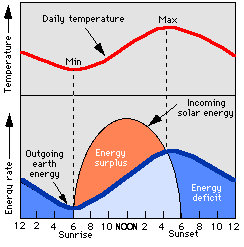
(Click image to view in separate window)
How much radiation does the earth's surface absorb? What causes the air to warm during the day? How does the temperature change over the course of a day? We will try to answer these questions in this section.

When we combine the break down of incoming radiation with the break down of outgoing radiation, we have the earth-atmosphere energy balance. The chart below displays the average break down of energy lost and gained at the earth's surface. The units used are relative to the amount of incoming radiation. Notice that the total energy lost at the earth's surface (lower left hand corner) is equal to the amount gained at the surface (lower right hand corner).

The net energy at the earth's surface can be thought of as the sum of the incoming energy minus the energy required to heat the air minus the energy to evaporate water. This simple equation is known as the energy budget equation. The energy used to heat the air is directed upward, away from the surface, and so is considered a subtraction. The same is true for the energy required to evaporate water. This energy, however, is in the form of a heat we can't feel. It is known as latent heat.
Bowen Ratio
The comparison between the amount of sensible heat and the amount of latent heat is often important when determining energy balance. As a quick method to compare the amount of sensible heat energy to the amount of latent heat energy, the Bowen Ratio was developed. It has the following form:
During the night, there is no incoming solar radiation, so the amount of sensible heat energy becomes minimal or even negative (loss of heat energy) . In these situations, the Bowen Ratio will be very small or even negative, as latent heat is not as dependent on incoming solar radiation.
 Let's look at the energy balance in terms of the daily variations in
temperature. Incoming solar energy is a maximum when the sun is highest in
the sky. But the surface of the earth warms continuously from the time the
sun rises to the time it sets. Therefore, the earth radiates its maximum
amount at sunset, and does not begin to slow down until the sun sets (no
more incoming radiation). The earth is releasing the least amount of
energy early in the morning, before the sun rises. The net energy at the
surface is therefore the difference in the incoming radiation (shortwave)
and the radiation emitted from the earth (longwave). The chart
demonstrates further. Here, the energy surplus area means that more energy
is entering the earth than is leaving it. The deficit area is just the
opposite -- more energy is lost by the Earth than gained (due to the
absence of sunlight). Remember, the total amount of net energy gained is
zero -- there is an energy balance. The surplus area on the chart is
showing the daily replenishment of energy into the Earth-atmosphere system
necessary to maintain that balance.
Let's look at the energy balance in terms of the daily variations in
temperature. Incoming solar energy is a maximum when the sun is highest in
the sky. But the surface of the earth warms continuously from the time the
sun rises to the time it sets. Therefore, the earth radiates its maximum
amount at sunset, and does not begin to slow down until the sun sets (no
more incoming radiation). The earth is releasing the least amount of
energy early in the morning, before the sun rises. The net energy at the
surface is therefore the difference in the incoming radiation (shortwave)
and the radiation emitted from the earth (longwave). The chart
demonstrates further. Here, the energy surplus area means that more energy
is entering the earth than is leaving it. The deficit area is just the
opposite -- more energy is lost by the Earth than gained (due to the
absence of sunlight). Remember, the total amount of net energy gained is
zero -- there is an energy balance. The surplus area on the chart is
showing the daily replenishment of energy into the Earth-atmosphere system
necessary to maintain that balance.
One important item to notice is that the earth's maximum emission of heat is skewed to the right (toward sunset) of the maximum incoming energy . Another key observation is that the earth emits and absorbs radiation much more efficiently than the atmosphere. That is why the late afternoon is often much warmer than at noon, when the incoming shortwave radiation is a maximum. That's also why the early morning is the coolest time of day. The atmosphere warms and cools slowly, but the ground warms and cools much more quickly. The next time you're outside, feel the ground with your hand. If it is mid-day, it will feel significantly warmer than the air. If it is late night, it will feel significantly cooler. Differences in the rate of radiation absorption and release are a major factor influencing energy balance. This, and other factors, are discussed in the next section.
 The Shodor
Education Foundation, Inc.
The Shodor
Education Foundation, Inc.